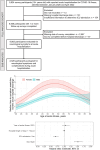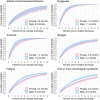Sex differences in post-acute neurological sequelae of SARS-CoV-2 and symptom resolution in adults after coronavirus disease 2019 hospitalization: an international multi-centre prospective observational study
- PMID: 38444907
- PMCID: PMC10914448
- DOI: 10.1093/braincomms/fcae036
Sex differences in post-acute neurological sequelae of SARS-CoV-2 and symptom resolution in adults after coronavirus disease 2019 hospitalization: an international multi-centre prospective observational study
Abstract
Although it is known that coronavirus disease 2019 can present with a range of neurological manifestations and in-hospital complications, sparse data exist on whether these initial neurological symptoms of coronavirus disease 2019 are closely associated with post-acute neurological sequelae of SARS-CoV-2 (severe acute respiratory syndrome coronavirus 2; PANSC) and whether female versus male sex impacts symptom resolution. In this international, multi-centre, prospective, observational study across 407 sites from 15 countries (30 January 2020 to 30 April 2022), we report the prevalence and risk factors of PANSC among hospitalized adults and investigate the differences between males and females on neurological symptom resolution over time. PANSC symptoms included altered consciousness/confusion, fatigue/malaise, anosmia, dysgeusia and muscle ache/joint pain, on which information was collected at index hospitalization and during follow-up assessments. The analysis considered a time to the resolution of individual and all neurological symptoms. The resulting times were modelled by Weibull regression, assuming mixed-case interval censoring, with sex and age included as covariates. The model results were summarized as cumulative probability functions and age-adjusted and sex-adjusted median times to resolution. We included 6862 hospitalized adults with coronavirus disease 2019, who had follow-up assessments. The median age of the participants was 57 years (39.2% females). Males and females had similar baseline characteristics, except that more males (versus females) were admitted to the intensive care unit (30.5 versus 20.3%) and received mechanical ventilation (17.2 versus 11.8%). Approximately 70% of patients had multiple neurological symptoms at the first follow-up (median = 102 days). Fatigue (49.9%) and myalgia/arthralgia (45.2%) were the most prevalent symptoms of PANSC at the initial follow-up. The reported prevalence in females was generally higher (versus males) for all symptoms. At 12 months, anosmia and dysgeusia were resolved in most patients, although fatigue, altered consciousness and myalgia remained unresolved in >10% of the cohort. Females had a longer time to the resolution (5.2 versus 3.4 months) of neurological symptoms at follow-up for those with more than one neurological symptom. In the multivariable analysis, males were associated with a shorter time to the resolution of symptoms (hazard ratio = 1.53; 95% confidence interval = 1.39-1.69). Intensive care unit admission was associated with a longer time to the resolution of symptoms (hazard ratio = 0.68; 95% confidence interval = 0.60-0.77). Post-discharge stroke was uncommon (0.3% in females and 0.5% in males). Despite the methodological challenges involved in the collection of survey data, this international multi-centre prospective cohort study demonstrated that PANSC following index hospitalization was high. Symptom prevalence was higher and took longer to resolve in females than in males. This supported the fact that while males were sicker during acute illness, females were disproportionately affected by PANSC.
Keywords: COVID-19; SARS-CoV-2; neurological complication; neurological long COVID; post-acute neurological sequelae of SARS-CoV-2 (PANSC).
© The Author(s) 2024. Published by Oxford University Press on behalf of the Guarantors of Brain.
Conflict of interest statement
The authors report no competing interests.
Figures




Similar articles
-
Persistent symptoms and clinical findings in adults with post-acute sequelae of COVID-19/post-COVID-19 syndrome in the second year after acute infection: A population-based, nested case-control study.PLoS Med. 2025 Jan 23;22(1):e1004511. doi: 10.1371/journal.pmed.1004511. eCollection 2025 Jan. PLoS Med. 2025. PMID: 39847575 Free PMC article.
-
Neurological manifestations of COVID-19 in adults and children.Brain. 2023 Apr 19;146(4):1648-1661. doi: 10.1093/brain/awac332. Brain. 2023. PMID: 36087305 Free PMC article.
-
Long-term outcomes of hospitalized patients with SARS-CoV-2/COVID-19 with and without neurological involvement: 3-year follow-up assessment.PLoS Med. 2024 Apr 4;21(4):e1004263. doi: 10.1371/journal.pmed.1004263. eCollection 2024 Apr. PLoS Med. 2024. PMID: 38573873 Free PMC article.
-
Long-Term Neurological Sequelae Among Severe COVID-19 Patients: A Systematic Review and Meta-Analysis.Cureus. 2022 Sep 28;14(9):e29694. doi: 10.7759/cureus.29694. eCollection 2022 Sep. Cureus. 2022. PMID: 36321004 Free PMC article. Review.
-
Psychiatric and neuropsychiatric presentations associated with severe coronavirus infections: a systematic review and meta-analysis with comparison to the COVID-19 pandemic.Lancet Psychiatry. 2020 Jul;7(7):611-627. doi: 10.1016/S2215-0366(20)30203-0. Epub 2020 May 18. Lancet Psychiatry. 2020. PMID: 32437679 Free PMC article.
Cited by
-
Type I Interferonopathy among Non-Elderly Female Patients with Post-Acute Sequelae of COVID-19.Viruses. 2024 Aug 28;16(9):1369. doi: 10.3390/v16091369. Viruses. 2024. PMID: 39339845 Free PMC article.
-
TLR2/NF-κB signaling in macrophage/microglia mediated COVID-pain induced by SARS-CoV-2 envelope protein.iScience. 2024 Sep 24;27(10):111027. doi: 10.1016/j.isci.2024.111027. eCollection 2024 Oct 18. iScience. 2024. PMID: 39435149 Free PMC article.
-
The Potential Role of Viral Persistence in the Post-Acute Sequelae of SARS-CoV-2 Infection (PASC).Pathogens. 2024 May 8;13(5):388. doi: 10.3390/pathogens13050388. Pathogens. 2024. PMID: 38787240 Free PMC article. Review.
References
Grants and funding
LinkOut - more resources
Full Text Sources
Miscellaneous
